Music ∷ Sam Porter
Show Artwork ∷ Nikolaos Pirounakis
Episode Artwork ∷ Lily Meek
In the field of world policy I would dedicate this nation to the Policy of the Good Neighbor - the neighbor who resolutely respects himself and, because he does so, respects the rights of others - the neighbor who respects the obligations and respects the sanctity of his agreements in and with the world of neighbors.
As part of their push for cultural unity and friendship with Latin America, Rockefeller appointed Francis Alstock and John Hay "Jock" Whitney in charge of the film division. Both men had experience with the film business, Whitney being one of the major investors on 'Gone with the Wind'. Their job was to encourage studios to create films that might promote Latin American culture, at the very least adding a sense of Latin American "atmosphere". They also coordinated tours of the continent from prominent Hollywood celebrities, but most seemed uninterested in cultural exchange and did only the bare minimum.
It was for this reason that, on the 30th of October 1940, Roy Disney was approached by the CIAA to see if the studio could “put some South American atmosphere in some of the short subjects in order to help the general cause along”. In most cases, studios had not gone further than using generic Latin American locations and stereotypes, without any specificity or understanding of South America’s cultural diversity.
Walt Disney had a different approach. Almost immediately, the studio began an intense period of research, gathering material on the peoples and cultures of each of the Latin American countries to see how they could be infused with the Disney style. An agreement was drafted between the CIAA and Walt Disney Productions for twelve Technicolor short subjects on Latin America.
There were two problems though. The first was that the previous goodwill tours had gone so badly that many of the Latin American countries had become resentful of them. In order to avoid any possible diplomatic mistakes, Disney was instructed to publicly avoid linking himself and the studio with the CIAA, instead framing the tour as what it partly was, a chance to research for upcoming projects. They were however able to publicly sell it as a collaboration with Pan American Airways, who would help coordinate the itinerary for the tour.
The other problem was the studio strike. The negotiations with the strikers were reaching boiling point, and the drop in staff was putting a strain on the projects coming to completion, including 'The Reluctant Dragon', Dumbo' and 'Bambi'. There were also concerns that, due to the political climate in South America, Walt’s refusal to negotiate with the strikers would create an image of him that the Latin American countries would reject. As a result, even though the tour was confirmed in everything but a formal written agreement, there were delays right until August.
Finally, on the 5th of August 1941, a formal agreement was executed between the United States Government and Walt Disney Productions for a field study of Latin America and twelve one-reel cartoons. Within a week, the eighteen-person tour began their trips to South America, with the tour officially beginning with Walt’s arrival in Rio de Janeiro on the 17th August.
The team was made up of Disney staff members and artists who both excelled in their fields and were also not part of the strike. They included:
- Norm Ferguson, animation director, who became the group supervisor
- Ted Sears, story artist
- Bill Cottrell, story artist
- Webb Smith, story artist
- Frank Thomas, the only member of the animation staff who went on the tour
- Lee Blair, a watercolour painter and concept artist, as well as a 16mm cameraman
- Mary Blair, also a watercolour painter and concept artist, and married to Lee
- Jim Bodrero, concept artist
- Charles Wolcott, composer and musician
- Larry Lansburgh, assistant to Norm Ferguson, and 16mm cameraman
- Jack Miller, story sketch artist
- Jack Cutting, the supervisor of foreign language dubs of Disney films
- John Rose, business manager
- Janet Martin, unit publicist
The tour began with ten days in Brazil, which was soon extended to three weeks. As soon as they arrived, Walt was greeted with adulation by the public and by important dignitaries, invited to a series of gala engagements that culminated in the grand Brazillian premiere of 'Fantasia'. In between events, the team immersed themselves in Brazillian culture, particularly the music. One song they found themselves particularly drawn to was Ary Barraso’s ‘Aquarela do Brasil’, which Walt first heard in a hotel in Belém. It was a wildly popular song in Brazil, but mostly unknown in North America. They were also charmed by the personality of the Brazillian parrot, the papagaio, and thought it might make for a potential character in the shorts. Even before they left Brazil, the tour was proving to be the most successful of the CIAA’s efforts, with Walt happily participating in public events and radio broadcasts, and the people of Brazil appreciating the respect imparted to them by the team. It was also here that the group christened themselves with an unofficial title: El Grupo.
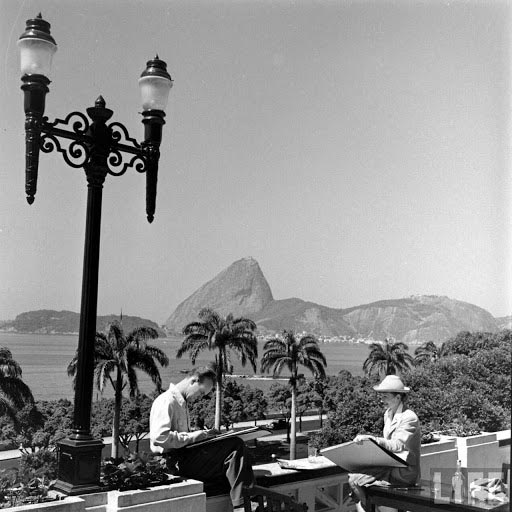
If the Brazillian leg of the tour had been a huge success, Argentina would prove to be even greater. The CIAA had asked El Grupo to give particular attention to Argentina, as the Nazis were establishing their strongest position there. Nazi press were already slandering the tour and Walt before they arrived, but the public embrace Walt was even greater here than in Brazil.

El Grupo arrived on the 8th of September, and quickly established a temporary studio in the Alvear Palace Hotel. They were particularly interested in exploring Argentina’s gaucho culture. The gaucho are a national symbol of Argentina and Uruguay, skilled horsemen renowned in culture and legend for their bravery and honour. Before leaving Burbank, they had already entertained the idea of a short centred around the gaucho, particularly after looking at the work of beloved Argentine artist Florencio Molina Campos, whose paintings of gaucho culture were beloved across Latin America and who the team had met briefly in Brazil. El Grupo were given the opportunity to witness gaucho culture first hand, and were warmly embraced, with the locals even dressing Walt in traditional gaucho attire.
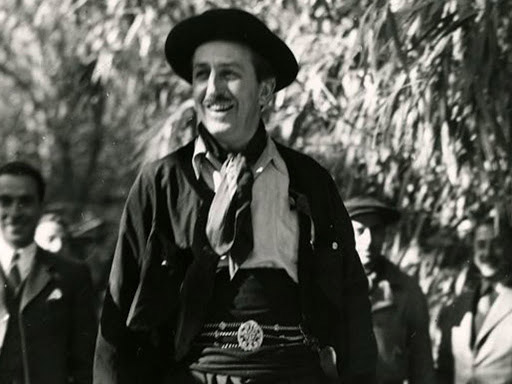
Towards the end of September, it was decided that El Grupo should split up and head for different parts of the continent in order to gather as much material as possible from Bolivia, Peru and the rest of Argentina, before reconvening in Chile. By the end of October, the team had returned to the United States with a mountain of artwork and material, as well as a deeper appreciation for Latin American culture, and were ready to put it all to work. For the CIAA, the goodwill tour had also been an enormous success, strengthening relationships between the two continents more so than any other participants in the Good Neighbor program.
Here's an unusual expedition: artists, musicians and writers setting out for a trip through Latin America to find new personalities, music and dances for their cartoon films. So, adios, Hollywood, and saludos, amigos.
Mixing four animated shorts with documentary footage shot by El Grupo during the tour, 'Saludos Amigos' acts as an imaginative tour around four of the Latin American countries, each short representing each country. In 'Lake Titicaca', Donald Duck acts as a tourist around the iconic lake on the border between Bolivia and Peru. In 'Pedro', an intrepid little plane named Pedro flies mail across the Andes to Chile. In 'El Gaucho Goofy', Goofy is introduced to the culture of the Argentine gaucho. And in 'Aquarela do Brasil', Donald is given a tour of Brazil by the Brazilian parrot Joe Carioca.

The original plan for the Good Neighbor shorts was for the twelve films to be developed in groups of four, with four shorts being produced simultaneously. Even though the bulk of the research had focused on Brazil and Argentina, the CIAA needed the shorts to cover all of the Latin American countries to avoid favouritism. This became especially important when it was decided to not only release the shorts in the U.S. as originally intended, but in Latin America as well, bolstered by the success of the tour.
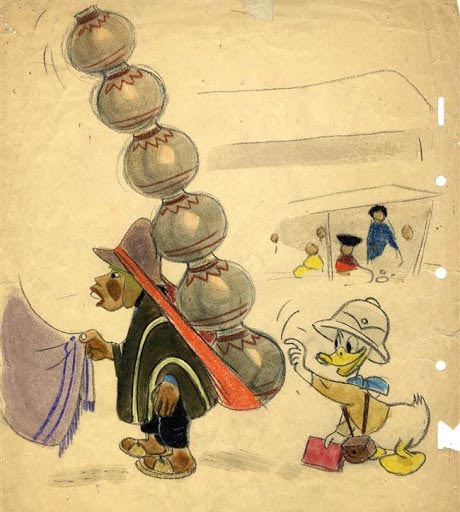
In parts of Bolivia and Peru, some of our artists were so enchanted with the colourful dresses and the life in general that they decided it would be a wonderful place for Donald Duck to flounder as a tourist - and that’s just what we’re doing.
'Lake Titicaca' was inspired by the watercolours Mary Blair had painted while visiting the region. In early development, Donald was visiting Titicaca as an archeologist, but it quickly changed to a tourist. This turned out to be an unexpected blessing - by presenting Donald as an ignorant North American tourist, they could construct gags at his expense rather than ones that reflected badly on Peruvian or Bolivian culture. This useful storytelling trick would be used through the shorts.
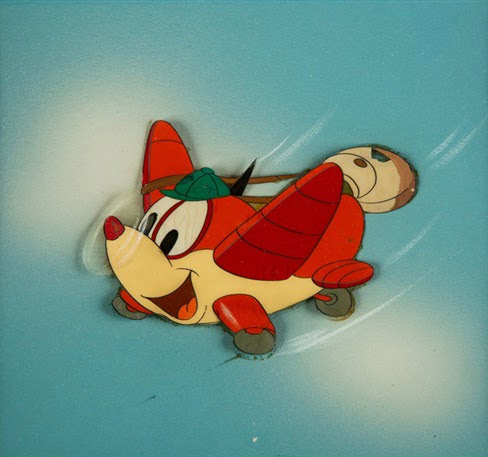
While 'Lake Titicaca' had been a direct response to experiences from the tour, the story for 'Pedro' was one the team had already started working on beforehand. It was intended as a good-natured nod to Pan Am, not one of the South American shorts, but El Grupo had returned with very little material from Chile. It was decided to adapt the story to a Chilean setting, with the little plane (now named Pedro) carrying mail across the dangerous Andes mountains. Though many found it charming, Chilean audiences criticised the sequence for not incorporating any elements of Chilean culture.
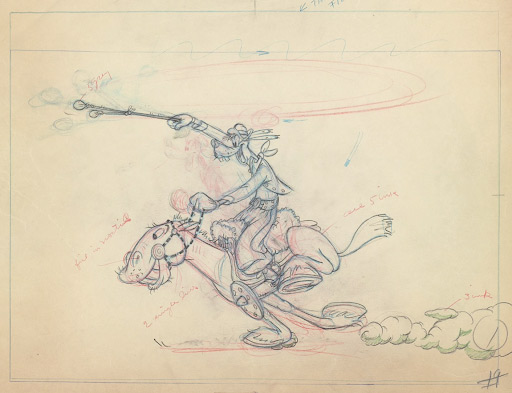
One of the focuses of the early research had been on gaucho culture, and the story team were keen to find a way to incorporate it into some of the short subjects. 'El Gaucho Goofy' turned out to be an ingenious marriage of extensive research, first-hand experience and the Disney style. The short carried over the format of the popular ‘How To’ series starring Goofy, adapting an idea already in the works called 'How to Be a Cowboy'. Again, as with Donald Duck, Goofy is a North American visiting Argentina, a cowboy learning the ways of the gaucho. This meant that they could throw ridiculous gags into the short without offending or misrepresenting gaucho culture. As with the series, instruction was given through narration, with Goofy responding by demonstrating what not to do.
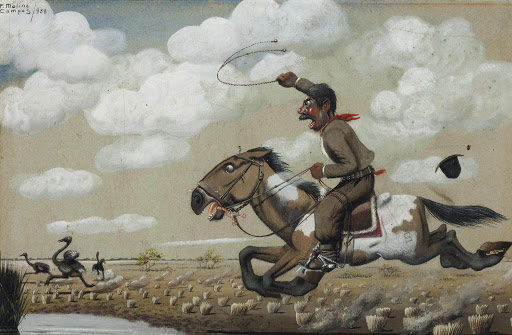
The short was heavily influenced by the art of Florencio Molina Campos, who was the only artist with whom Disney made a formal agreement, despite the many connections they had made in Latin America. Though he insisted on being the lead artist on the short, his involvement extended only to his paintings being used as reference for the backgrounds. Both Molina Campos and the audiences in Argentina praised the film for its respect to gaucho culture.
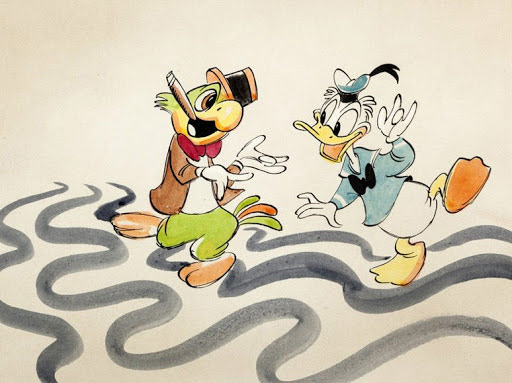
The most innovative of the first four shorts was named after the song by Ary Barraso, the title of which translated to "Watercolours of Brazil". The sequence would also incorporate another popular song, 'Tico-Tico no Fuba' by Zequinha de Abreu, another song that El Grupo had heard while in Brazil. Rather than driven by narrative, the short would be an impressionistic portrait of Brazil using a watercolour motif. It was the first time Disney animation had used the concept of a paintbrush creating the environments and characters on-screen, a concept that would be used in many of their later educational films.
Donald Duck makes another appearance in 'Aquarela do Brasil', once again as a tourist, and we are also introduced to a new character, the Portuguese-speaking parrot Joe Carioca, inspired by the papagaio the team had been so charmed by in Brazil. Driven by a recording of the song by Aloyiso Oliveira, the short was a natural progression of the Fantasia style, marrying experimental animation with highly evocative music.
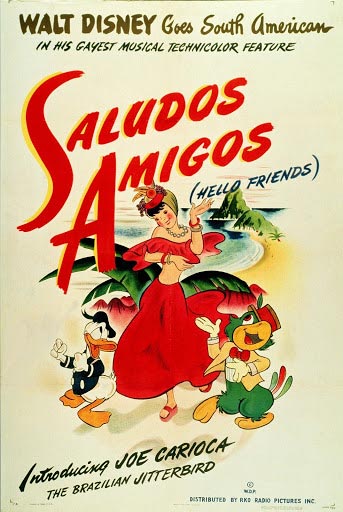
The film had its world premiere on the 24th of August 1942 in Rio de Janeiro under its Portuguese title 'Alô, Amigos', and was an instant smash hit. Over the following months, the film was released through Latin America, always to great acclaim and packed houses. Audiences were thrilled to see their cultures so respectfully combined with the popular Disney style, and the predominant complaints were from countries upset at not being represented. The original plan had been for the feature version to be shown in Latin America and the four shorts released separately in the U.S., but the success in South America convinced RKO to release it feature form instead. The contract with the CIAA was also rewritten as a result, now for three features instead of twelve shorts.
I think up to now we have all been thinking of the barriers between the Americas: distance and different languages and different backgrounds. And now, rather suddenly, we see that these things don’t matter. Our backgrounds are different, but our future, we know, has to be the same. The cowboy and the gaucho understand each other because both of them ride the plains as free men, not slaves. And Donald Duck and Joe Carioca will always be friends, I believe, because they’re both grand independent spirits, meant for the pleasure of people who are not afraid to laugh… While half the world is being forced to shout “Heil, Hitler”, our answer is “Saludos Amigos!"
Renamed 'Saludos Amigos', the first of the Good Neighbor films premiered in the U.S. in February 1943, and just as in Latin America, was a commercial success and warmly received. After the high art of 'Fantasia' and 'Bambi', many saw it as a return to the grounded charm of the early Disney films, and were intrigued by its portrait of Latin America. As a result of the film’s success, both 'Aquarela do Brasil' and 'Tico-Tico no Fuba' were big commercial hits, the former translated into English as 'Brazil' and becoming a popular standard. In 1985, director Terry Gilliam would use the song for the opening of, and inspiration for the title of his film 'Brazil'. The film also received three Oscar nominations, the most of any Disney feature until that point, including Best Musical Score, Best Sound Recording and Best Song for 'Saludos Amigos', the title track and only original song in the film.
'Saludos Amigos' was unusual among the early Disney features for another reason - it actually made a profit on its initial release, not a major one, but enough to label the project a success. By the time the film was in release though, Walt Disney and the Good Neighbor team were hard at work on the second film, another package film of four short subjects.

Mary was born Mary Browne Robinson in Oklahoma in 1911, and after graduating from college in 1931, received a scholarship to the Chouinard Art Institute in Los Angeles. Not long after graduating from Chouinard, she married Lee Blair, who shared with her a passion and skill with watercolour art.
After early experiences in animation at MGM and Ub Iwerks’ studio, Mary joined Disney in 1940, contributing concept art to 'Dumbo' and an early version of 'Lady and the Tramp'. She had joined reluctantly, and by the time of the South America tour, Mary had left the studio. Her work on the tour though had a profound impact on Walt and the other artists, who saw Mary’s work as the strongest response to the Latin American culture they were immersing themselves in. Upon returning to Burbank, Disney made her one of the primary art directors on the Good Neighbor shorts, her work at Lake Titicaca in particular informing the visual language the films would use.

Over the next decade, Mary would have an enormous impact on the style, look and use of colour in Disney animation, providing stunning concept art for 'Alice in Wonderland', 'Cinderella', 'Peter Pan', many of the sequences in 'Make Mine Music', and the animated sequences in 'Song of the South' and 'So Dear To My Heart'. Her hand is particularly felt in the films of the 1950s, and Walt ordered the animation staff to adhere as close as possible to Mary’s colour stylings and art direction, a task the animators found almost impossible.
Mary left the studio in 1943, but her influence persisted, with Walt’s frustration at her specific flair not translating effectively to final animation prompting his extreme pursuit of visual consistency on 'Sleeping Beauty'. Mary had a very successful career as a graphic artist and illustrator, including illustrating several Golden Books, but during planning for Disneyland, Walt approached Mary to provide concept art for the ‘It’s A Small World’ ride. She would continue her relationship with Disney, providing murals for both Disneyland and Disney World.
Mary Blair died in California in 1978, and continues to be recognised as an extraordinary artist to this day, including a picture biography for children published in 2017. Her work has been shown in retrospective exhibitions in Tokyo and at the Walt Disney Family Museum, and she was named a Disney Legend in 1991. If the Silver Age films of the ’50s have now become our classical definition of the Disney style, it isn’t a stretch to credit Mary Blair as its chief influence. Her work is dynamic, charming, arresting and inspired, and perfectly captures the romanticism of the stories she influenced. Her influence on Disney animation, and on animation itself, is amongst the most significant of any individual artist.
Some fun, eh, kid?
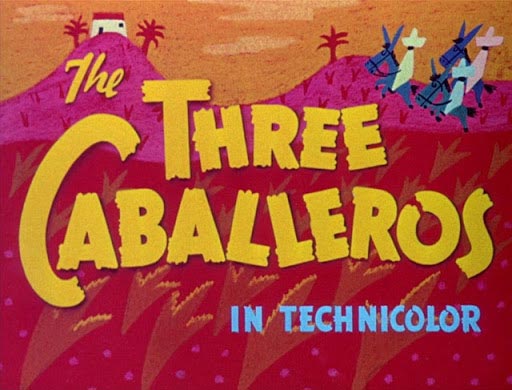
Donald Duck receives a package from his friends in Latin America for his birthday, filled with presents. The first is a projector and a film about exotic birds, including a story about a penguin who loves warm weather and a gauchito who finds a flying donkey. In another, he finds a story book from Brazil, out of which jumps a miniature Joe Carioca who takes Donald on a tour of Bahia. Lastly, out of his present from Mexico bursts the bombastic rooster Panchito, who gives Donald a piñata and takes him and Joe on a tour of Mexico on a magic flying sarape, ending in a surreal burst of colour and music.
It is a mistake to talk of these sequences as short subjects. This may have been the trade paper’s language, but we should all guard against calling these short subjects. Instead it would be better to refer to them as Mexican sequence, Brazilian sequence, Cuban sequence, etc., all woven together into a musical feature. Referring to these pictures as a group of shorts creates terrific sales resistance because it lessens the people’s appreciation of the subject and belittles the entire picture and immediately sets up a value in the exhibitors’ minds of 4 times the short subject price.
The second Good Neighbor film, 'The Three Caballeros', had one major advantage over 'Saludos Amigos' - it knew it was going to be a feature from the beginning. While the inherent form of the film would be similar, the knowledge that the sequences weren’t being developed as stand-alone shorts gave the Disney staff permission to push the boundaries, not just of the short subject but of what animation was actually capable of. The film would be built around the next four Good Neighbor shorts, but while the first two would carry over from early planning on the series, the last two would be new ideas influenced both by the reception of Saludos Amigos and an opportunity to push the technology of animation into unexpected directions.
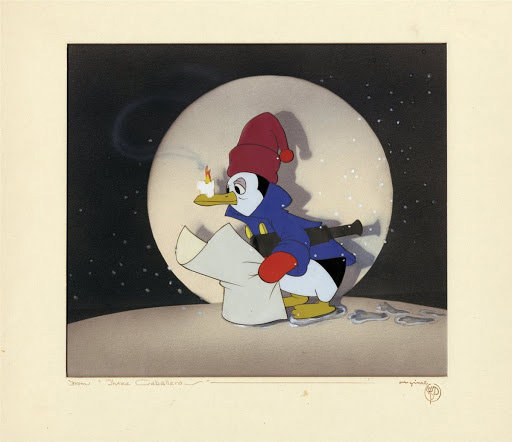
Rather than choosing one location though, the journey of Pablo the cold-blooded penguin mirrored that of El Grupo on their return journey to the U.S., travelling up the west coast of the continent before settling in the Galapagos Islands. In that sense, 'The Cold-Blooded Penguin' is only tangentially a Good Neighbor film, and has almost no discernible relationship with Latin America outside of the places Pablo spies through his telescope.

Once again, there was careful thought put into not offending gaucho culture, but this story didn’t have a North American character to act as a foil. Instead, the plans for the series as a whole were that they would be narrated by an adult reminiscing about his childhood, which are depicted in the animation. This allowed for harmless slapstick humour as we watch this little boy make mistakes in the process of learning.
One of the countries to complain of not being included in 'Saludos Amigos' was Uruguay, so it was decided late in the making of the sequence to shift the setting from Argentina to Uruguay. This was done by simply adding a line of dialogue at the beginning of the short, contextualising the location. The problem was, the representation of gaucho culture was very specific to Argentina, and the landscapes of the two countries were completely different. For this reason, the version released in Uruguay omits the new line in an attempt to not cause offence.
'The Flying Gauchito' was originally intended to be the Argentinian short in what would become 'Saludos Amigos', until 'El Gaucho Goofy' was chosen instead, putting it in perfect shape to be included in 'The Three Caballeros'. Another short in the gaucho series, 'The Laughing Gauchito' was also in development, getting as far as beginning rough animation, but it was never completed. For the Laserdisc release of the two Good Neighbor films in 1995, a rough version of the short was constructed.

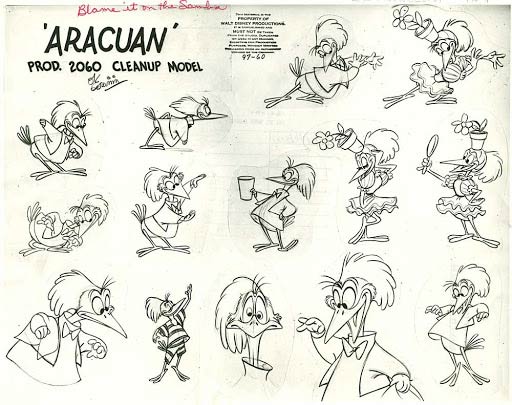
He appears in Donald’s film, breaking both the fourth wall and the logic of the film itself, letting out a scream and dashing around the screen to a frantic and insane song. This would not be the only moment of disruption in the film from this strange, infectious figure.
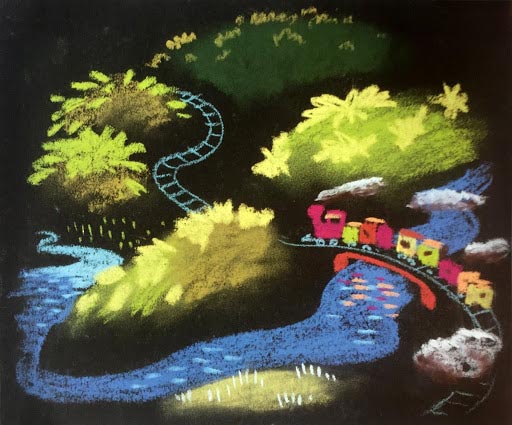
The first part presents a romantic view of Salvador, the capital of Bahia, accompanied by the samba ‘Você Já Foi à Bahia?’ by Dorvil Caymmi, after which Joe and Donald jump on a train to visit Bahia themselves. This sequence is the most direct translation of Mary Blair’s artwork, mirroring her two-dimensional and highly colourful style. It also features a return appearance of the Aracuan.
When Donald and Joe arrive in Bahia though, the film takes a very different visual direction. The combination of live action and animation wasn’t a new concept, even for Walt Disney, but the possibilities for the process were limited. For Baía, it was decided to capitalise further on the current interest in Latin America in the U.S., driven by the sudden success of the Good Neighbour initiative. In mid 1942, Walt Disney approached Aurora Miranda, sister of singer Carmen Miranda and acclaimed in her own right, to appear in the film. She would be paired with another song from Ary Barossa, 'Os Quindins de Yayá', and would appear on-screen interacting with Donald and Joe.
To begin with, a rear-projection process was used for the combination scenes. The animation was completed first, then projected using the rear-projection process, with Miranda standing in front of it and reshot. This proved an enormously difficult process, and while Miranda was in focus, the animation inevitably lost a lot of detail. One of Disney’s earliest collaborators, Ub Iwerks, came up with a solution. Iwerks had returned to the studio in 1940, heading a new special effects department. He developed an optical printer that allowed for a number of elements to be combined with the film without multiple exposures. Not only did this mean that the animation would still be in focus, but that animated action could happen in the foreground as well. It was a radical invention, allowing for Miranda, her band and dancers to interact even more within the animated environment.
The sequence also featured another song by Ary Barossa, 'Na Baixa do Sapateiro', now with English lyrics and retitled 'Baía'.
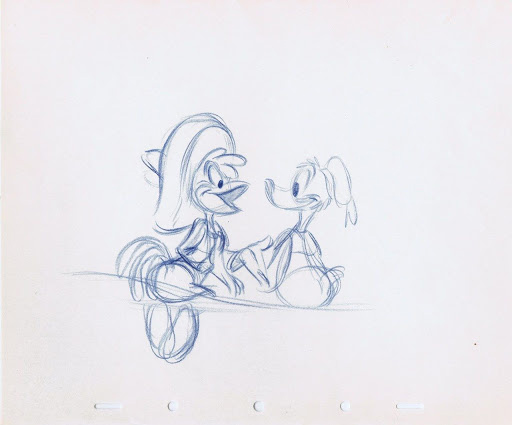
As with the Brazillian sequences, the Mexican sequence would be led by the music. For the introduction of the new character Panchito, a raucous, gun-toting Mexican rooster, Manuel Esperón’s song 'Ay, Jalisco, no te rajes!' was used, now with English lyrics by Ray Gilbert and renamed ‘The Three Caballeros'. The song, originally about the relationship between the Mexican state of Jalisco and its capital city of Guadalajara, was now reframed as a statement on hemispheric unity, represented by a Mexican (Panchito), a Latin American (Joe Carioca) and a North American (Donald Duck). The sequence was animated by Ward Kimbell, and shattered the rules of Disney animation at the time. It was explosive, energetic, anarchic, chaotic and self-aware, with moments of characters exiting one side of the frame and entering on another, extreme manipulation of object and form, and even pushing against the walls of the film frame itself, including a giddy reinterpretation of the Soundtrack sequence from 'Fantasia'. Rather than shocked, Walt adored it. In 1969, Kimball called the sequence “the only animation I can look back on with pride”.
'La Pinãta' also pushed the boundaries of combination scenes even further. On their journey on the flying sarape, Panchito introduces Donald and Joe to the sights and sounds of Mexico, all defined by women. They fly to Acapulco, where an uncomfortably lustful Donald chases the women on the beach, interacting directly with live-action objects in a real environment. The film then enters a dream-like landscape, with singer Dora Luz singing a new English version of 'Solamente una vez' by Agustín Lara, now retitled 'You Belong To My Heart'. Donald pursues Dora, her face floating through animated environments. With the entrance of dancer Carmen Molina, the film elevates once more, a surreal landscape of dancing cacti and striking silhouettes, before culminating in an insane collision of sight, sound and colour, with Donald as a raging bull, even stranger combinations of animation and live action, and finally fireworks, where red, white and blue sparkles spell out the end in all three of the languages in the film. Nothing like the work in 'La Pinãta' had ever been seen before, animation pushed into unexpected and overwhelming directions. If 'Saludos Amigos' had been charming and modest in its execution, 'The Three Caballeros' completely embraced its theatrical opportunities - for better or worse.
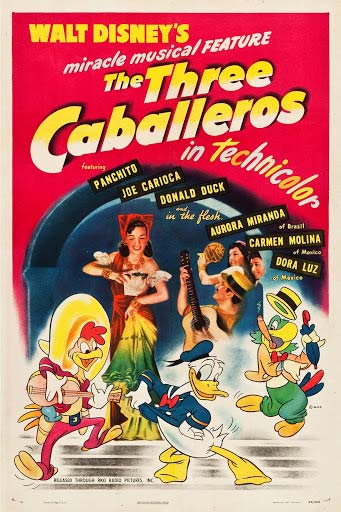
It premiered in the U.S. in New York City on the 3rd February 1945, and its reception was mixed. Some critics found it charming, Variety calling it “a new form of cinematic entertainment”, while others found it garish and ridiculous, Woolcott Gibbs in the New Yorker calling it “a mixture of atrocious taste, bogus mysticism, and authentic fantasy, guarantee to baffle any critic not hopelessly enchanted by the word “Disney””. Even those who had praised the studio in the past found Caballeros hard to stomach, criticising its aural and visual insanity, and Donald’s uncharacteristic lustfulness.
The film also didn’t perform nearly as well at the box office as its predecessor, certainly compared to the enormous cost of the film. A number of the songs from the film also became enormous hits though, even the title number, and have endured in the public consciousness more so than the films themselves. The film was also nominated for two Oscars, for score and sound recording.
Both 'Saludos Amigos' and 'The Three Caballeros' would have a strong cultural legacy, albeit not necessarily in their original form. In 1955, many of the sequences were excised from the films and released individually, and an edited version of 'Caballeros' premiered in television in December 1954, retitled 'A Present for Donald'. The characters, including the Aracuan, would appear over the years in other Disney short subjects, particularly in the education films in the ’50s, many of which were influenced by the storytelling techniques developed in 'Saludos Amigos'. The films have also enjoyed rediscovery and reassessment, especially thanks to home video. 'The Three Caballeros' in particular is now admired for its enormous technical and stylistic inventiveness.
Carnival was eventually abandoned, but many of its ideas endured. The most immediate legacy of the two Good Neighbors films was their suggestion of a new kind of feature film, a collection of short subjects that were much quicker and cheaper to produce than the elaborate Golden Age films. Now that the war was over, and their government contracts had expired, Walt Disney Productions was not in a financial position to pursue feature filmaking, even though a number of projects, including 'The Wind in the Willows', 'Alice in Wonderland' and 'Peter Pan' were still in development. The idea of a "package film" seemed much more achievable. Walt was also intrigued by the possibilities 'Caballeros' had opened up with combining live action and animation, a process that seemed to lend itself to another long-gestating project, his adaptation of the Uncle Remus stories of Joel Chandler Harris, 'Song of the South'.
In the meantime, Disney feature animation would enter its most peculiar period, with a series of four films that represented an unexpected intersection between the Good Neighbor films and 'Fantasia', making use of abandoned ideas from both. For the next few years, Disney animation would be forced to survive in the form of the Package Films.
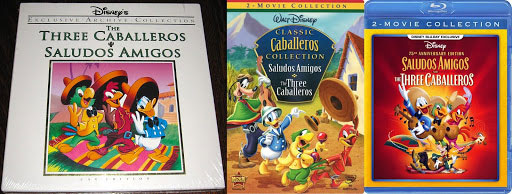
- Both films made their VHS debut in the 1980s, with 'The Three Caballeros' in 1982 and an international release of 'Saludos Amigos' in 1983. 'The Three Caballeros' would be rereleased on VHS many times in the 80s and 90s, but 'Saludos Amigos' would not be released on the format in the U.S. until the censored VHS release in 2000.
- The most elaborate release of the films was the Exclusive Archive Collection laserdisc in 1995, which included both films and a strong collection of extra material, including behind-the-scenes footage, newsreels, deleted and abandoned material, and the first public release of the CIAA internal documentary short South of the Border with Disney. Apart from the documentary short, none of this material has ever been made available on home video again. 'The Three Caballeros' would also have a number of its own Laserdisc releases.
- Both films were released on DVD as part of the Gold Classics Collection in May 2000. For this release, 'Saludos Amigos' was censored, removing a moment of Goofy smoking a cigarette. It did however include 'South of the Border with Disney'.
- The films would be bundled together again for the 'Classic Caballeros Collection' on DVD in 2018, still with 'South of the Border with Disney'.
- The uncensored version of 'Saludos Amigos' was included as an extra on the DVD release of the documentary 'Walt and El Grupo', documenting the Goodwill Tour of 1941, released in 2010.
- For the 75th anniversary of 'Saludos Amigos', both the uncensored version of the film, along with 'The Three Caballeros', was released on Blu-ray exclusively through the Disney Movie Club in January 2018. No special features were included. This is the only version of the films available on Blu-ray, and the most recent release of a classic Disney animated feature in the format.
- Both 'Saludos Amigos' and 'The Three Caballeros' are available on Disney+, with 'Saludos Amigos' censored.
- South of the Border with Disney: Walt Disney and the Good Neighbor Program (1941-1948), JB Kaufman, 2009
- Wikipedia for Saludos Amigos, Mary Blair and The Three Caballeros
- Walt and El Grupo, dir. Theodore Thomas, 2008
- Walt Disney: The Triumph of the American Imagination, Neal Gabler, 2006













